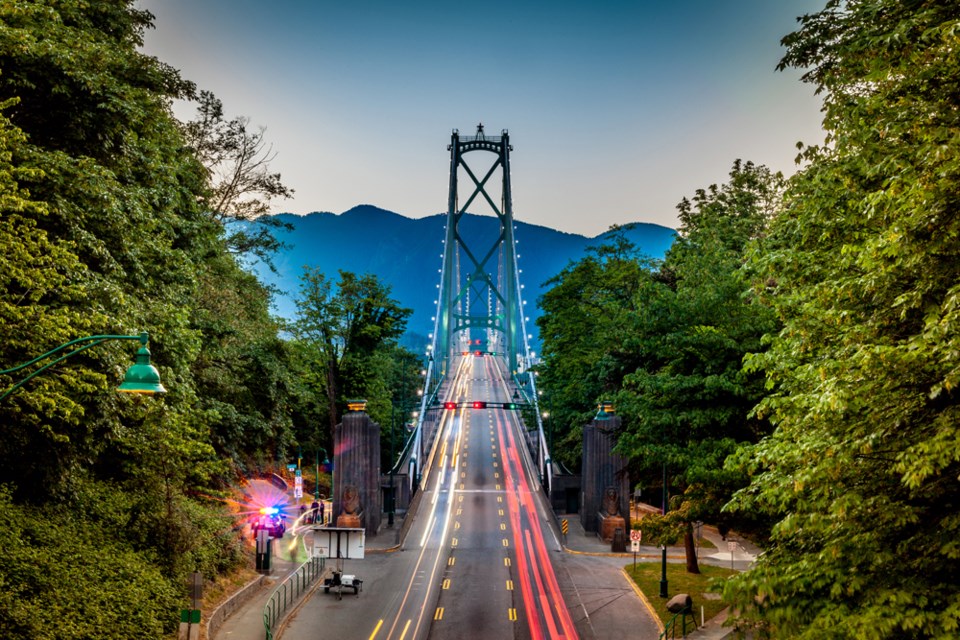When I told people last year I was moving to West Vancouver, one by one they had the same reaction that combined sympathy, well-wishing and foreboding, amounting to: “You’re going to have to deal with the bridge.”
I suspect the way they perceived “the bridge” was the way they perceived shingles or an infestation of ticks. Their message was that I might as well forget about ever being on time or commuting reliably, that I’d miss dinners and appointments and soon bear considerable regret for ever going “over there.” To them, it was as if I were switching political alliance or choosing a new hockey team to like.
My message to them today nearly a year into the exercise is that they can dial it back. The Lions Gate Bridge is not nearly the challenge I imagine it once was. Endless gridlock is an ancient, phantom menace. It can be an opportunity for reflection inside a vehicle, helpful if you’re eager to get through an audiobook a little more efficiently, but mostly it moves. Only when the bridge is the scene of a fender bender or a stall or a more serious emergency matter is it stifled.
The pandemic hasn’t been good for many things, but for the North Shore and Lions Gate it has been a relief – as in about a 10 per cent decline in daily traffic.
Pre-COVID-19 in 2019, the annual average traffic was 61,970 weekdays and 54,307 on weekends. When the pandemic hit in 2020, weekday traffic was slashed to 30,609 in April from 60,700 in February.
It has been gradually restoring since then, but only nominally in recent times. The 2022 averages were 54,271 weekdays (about what it was on weekends in 2020) and 49,265 on weekends. (There is an historic bump of a couple of thousand each day in summer months.)
What that suggests is that some of us have agency and flexibility to work from home. Public transit numbers across the region haven’t yet returned to pre-pandemic levels, either, so there is evidence that companies are accommodating those demands. Rising inflation has made it more difficult to attract workers to come here and more expensive to hire workers for here, so perhaps the traffic decline also reflects the labour shortage.
What I wondered, though, is who makes the call about the direction of the three lanes and which direction gets two of them. How much is manually done and how much is automated?
I connected with a senior official with the provincial transit ministry to understand the oversight of this and other bridges by the contracted firm, Miller Capilano Highway Services Ltd. The Traffic Management Centre in Coquitlam has a set of local operations teams, one of which monitors the 46 cameras that span the Lions Gate and its feeder networks. The system is backed up at either end of the bridge.
At any given moment, across all three work shifts in the day, there is one person with eyes on nothing but those cameras, evaluating the gathering of traffic at the north or south ends. An important part of the teamwork now involves alerting drivers through social media of any serious problems.
There is a common pattern of 6-9:30 a.m. with two southbound lanes and a 3-7 p.m. pattern of two northbound lanes, but it’s not etched in stone. Priority is given to first responders who need to get on or over.
The largest issue is the challenge to absorb traffic into downtown Vancouver along Georgia Street. The North Shore, by comparison, has four ways to disperse incoming traffic.
I asked if there is anything, anyone, at any time has devised to make progress with the general crush that meets the weekend travellers from Whistler and Squamish or the Sunshine Coast and the ferry into Vancouver and stretching for blocks on the North Shore and the downtown. The Second Narrows Bridge gets clogged, too. The downtown is backed up for blocks.
Three answers stood out to contend with the Lions Gate:
1. There is no quick fix.
2. A new crossing is a lovely idea in principle, but in practice there isn’t a place for it.
3. Learn to love the bus.
Kirk LaPointe is publisher and executive editor of BIV as well as vice-president, editorial, Glacier Media Group, the North Shore News’ parent company. He is also a West Vancouverite.



